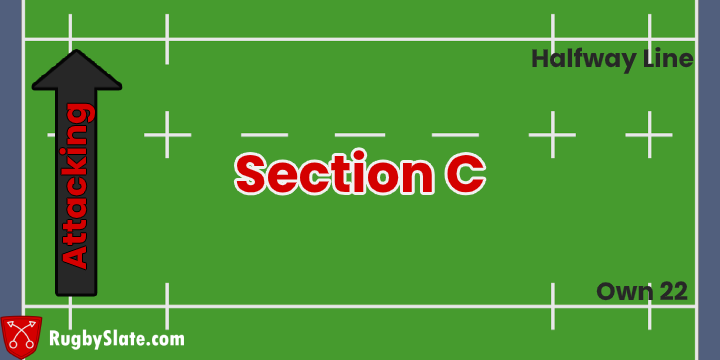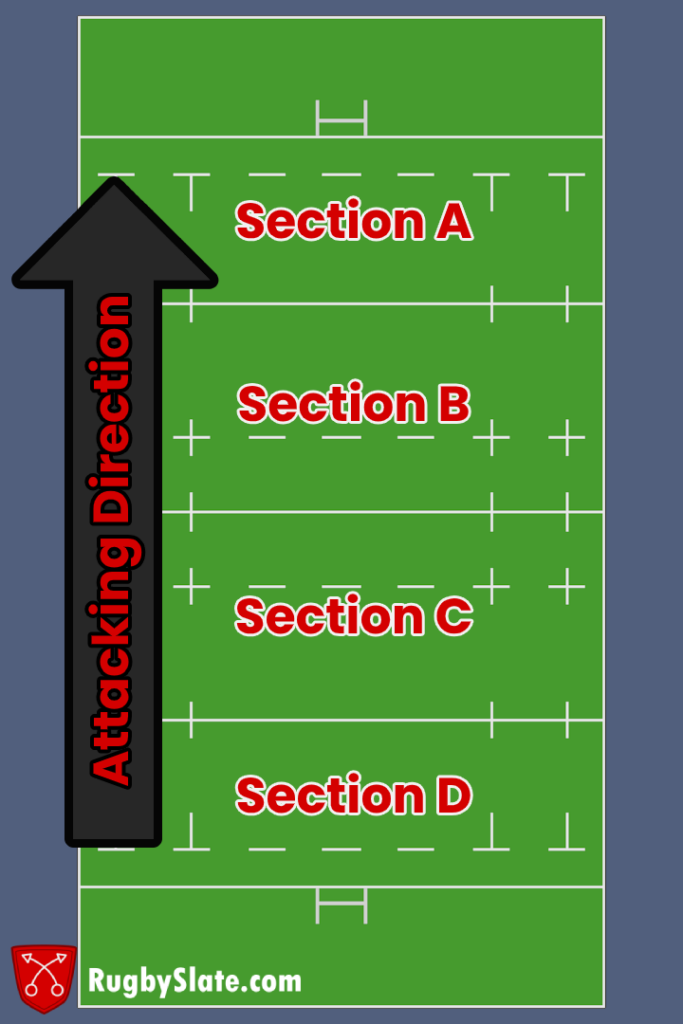Defending Sections of The Pitch
An important aspect of understanding how to play rugby effectively, is understanding “how” to play the game in different parts of the pitch. When the play is occurring at different places on the field, the intent of the attack and the defence should change accordingly. The easiest way to define what should be done in each area of the field is to split it into distinct areas. It should be noted that everything in this article is up for debate and that it shouldn’t be taken as fact; your team/playing style as well as that of the defence may change how you wish to play in certain sections of the field. Take this article as a basic, core philosophy which should be altered and adapted for each team and maybe even for each opposition.
A good way to split the field is into four sections down the field; A – try line to opposition 22, B – opposition 22 to half way, C – halfway to own 22, D – own 22 to try line.
Section A

This is clearly the best part of the field to be in defence, the attacking side are under a lot of pressure to get out of this region and any mistake can easily result in a try. The first thing to note is that the attack more than likely will being looking to kick to clear their lines. If they haven’t taken the ball back into the 22 themselves they will be able to kick directly in to touch which should be kept in mind for the defence. The wingers and full back should be standing at range where the ball will roughly be kicked out so that if the ball doesn’t go out a counter-attack can be launched. If the ball does go out it typically isn’t worth taking a quick lineout as the ball will still be in the opposition half so regrouping and taking a lineout will allow a good base to launch an attack from. In terms of the lines defence, if it is clear that a player is going for a kick, a blitzing charge down works well to put pressure on the kicker and try to force a mistake. Any other phases in this area for the opposition will typically be just to move the ball into a more favourable part of the field and to set up a good base to kick from therefore the defence need to be strong in their tackles and make the opposition work for every phase. Discipline is very important as giving a penalty away here completely releases the pressure of the other team and all the hard work goes to waste.
Section B

Section B has some similarities with Section A, the attacking team are more likely going to kick but this time, kicking directly to touch is not an option. Instead kicking will either be an up-and-under kick so they can compete for the ball, or a tactical, longer kick that is to either get the ball to bounce out or to get the defence back in their own 22. Therefore the back 3 and even the 9 have an important job covering all these angles, just being in the right position should be enough to stop any attempts but if they do kick then they should be covered. For the defencive line, a full aggressive blitz probably should not be used as it is very tiring and mistakes are costly. Chances are that the attack or not going to be trying any complex wide moves therefore defence should be simple and focus on the close channels to the breakdown.
Section C

In the defences own half, things get a bit more important, linebreaks can easily turn into tries so there can be no missed tackles. In this section the attack will start to play wider, looking to test the defence and find gaps. The drift defence will be good opposition to this as it allows for a lot of ground to be covered by the team. However if the attack do have the upper hand and have overlaps, a blitz defence must be employed to quickly shut down the attack and stop the ball getting wide. Penalties here with either lead to a kick on goal or a good lineout position, both of which are not great for the defence. For the backfield, there is still a risk of kicks however the type of kicks will have changed. On the ground grubber kicks to get behind the defence will be used, these might also be targeted at the corner flags to force the defence to take a lineout deep in their 22. The only saving point for defending a kick is that if it is caught on the full in the 22 a mark can be called. This is a great way to relieve pressure on a defensive team and push the opposition back.
Section D

This is clearly the worst place on the field to be defending, any breaks through the defence will lead to a try and any penalties will lead to 3 points or an attacking lineout on the 5 meter line. The emphasis for the defending team should be intensity when defending in their 22. They should look to get off the line quickly and put pressure on the opposition through a hard blitz defence, drifting if necessary. Sending players into a ruck where the chance of the turnover is low should be avoided as having as many people in the defensive line as possible is very important. If there is an opportunity to steal the ball, drive them out or get a turn over any other way, these should be aggressively taken however this should not be at the detriment of the defensive line if it is unsuccessful. Attacking kicking in this part of the field will only really take the form of a grubber kick to exploit the space behind the defencive line. To defend against this, the 15 and the 9 should be sweeping behind their team, working with the wingers to cover this area and join the line when needed. Displine is very important in this section as penalties not only give the attack either a good lineout or a kick at goal; but penalties can also give the attack a “free play” with the advantage which can lead to a try.

